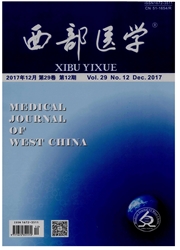

 中文摘要:
中文摘要:
目的 通过脂质体法干扰和过表达肠上皮细胞的热休克转录因子2(heat shock factor 2,HSF2),探讨其对肠上皮细胞炎症反应的影响和涉及的信号通路,为溃疡性结肠炎发病机制及诊治靶点提供线索。方法 选取结肠肿瘤上皮细胞Caco-2作为研究材料,采用脂质体法分别转染HSF2siRNA和pCMV-HSF2-FLAG重组质粒,四甲基偶氮唑蓝(MTT)法检测转染前后细胞生理特性的变化;并用脂多糖(LPS)刺激转染组及对照组细胞,Griess Reagent System测定各组细胞的NO浓度;RT-PCR检测细胞炎性酶iNOS、COX-2,炎症因子TNF-α、IL-8mRNA转录水平;ELISA检测细胞培养基中TNF-α、IL-8含量;Western Blot检测COX-2、IκB、NF-κB p65蛋白水平,以及ERK1/2、JNK和p38磷酸化水平。结果 MTT法检测结果显示,脂质体法转染入siRNA或重组质粒对细胞活性无显著影响;干扰HSF2后,LPS刺激Caco-2产生iNOS、COX-2、TNF-α及IL-8,在mRNA和蛋白水平均较对照组表达上调(P〈0.05),这一过程中信号通路IκB表达降低,而NF-κB p65表达升高,MAPK中ERK1/2磷酸化水平降低,而JNK和p38则呈增强趋势。转染入重组质粒过表达HSF2后,结果则相反。结论 HSF2通过增强ERK1/2蛋白磷酸化水平,抑制JNK、P38及NF-κB表达,能有效抑制LPS引起Caco-2细胞的炎性酶及炎性因子的表达,在炎症反应中起保护性作用,对研究溃疡性结肠炎的发病机制提供线索,可能成为其治疗新的靶点。
 英文摘要:
英文摘要:
Objective To study the role of anti-inflammatory of HSF2 through over expressed and knocked-down on inflammatory reaction and its mechanism of human colonic epithelial cell. Methods Caco-2 cells were transfected with HSF2 siRNA and recombinant plasmid (pCMV-HSF2-FLAG) using Lipofectamine. Cytotoxicity was estimated by the MTT (3-E4,5-dimethyl-2-thiazol-2-yl]-2,5-diphenyltetrazolium bromide) assay. After LPS stimulated the different treatment ceils, Nitric oxide (NO) were measured by Griess reagent. The protein and mRNA expression levels of inducible nitric oxide synthase (iNOS), cyclooxygenase-2 (COX-2), tumor necrosis factor a (TNF-a) and interleukin-8 (IL-8) were analysed by Western Blot, ELISA and RT-PCR, respectively. Phosphorylation levels ofextracellular signal-regulated kinase 1/2 (ERK1/2), c-Jun N-terminal protein kinase (JNK) and p38 mitogen-activated protein kinase (p38 MAPK) , inhibitor κBa (IκB-a) and nuclear factor-κB p65 (NF-κBp65) were measured by Western Blot. Results The cell by treated by Lipofectamine means did not decrease the viability of Caco-2 cells. Silenced HSF2 significantly attenuated the LPS-induced expression of NO, iNOS, COX-2, TNF-α, IL-8 in Caco-2 cells(P〈0.05). In addition, It increased phosphorylation of IκB-a, NF-κB, JNKand p38,but decreased ERK1/2. The effect of over-expressed HSF2 on the above index’s was contrary. Conclusion This study indicates that HSF2 inhibited LPS-induced proinflammatory enzymes and proinflammatory cytokines via up-regulation ERK1/2, but, down-regulation phosphorylation of JNK, p38 MAPK and NF-κB pathways. HSF2 has a potential anti-inflammatory properties , might be a new clue to reveal the pathogenesis of UC and a new target for intervention in the inflammatory response .
 同期刊论文项目
同期刊论文项目
 同项目期刊论文
同项目期刊论文
 期刊信息
期刊信息
